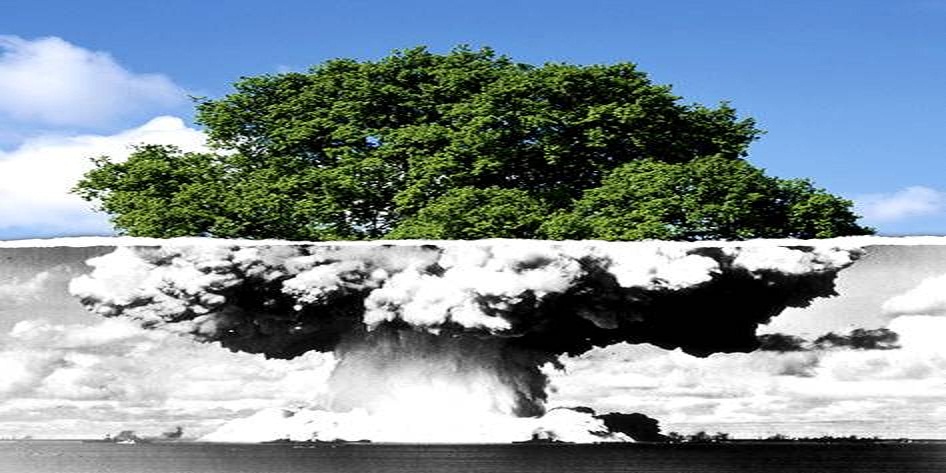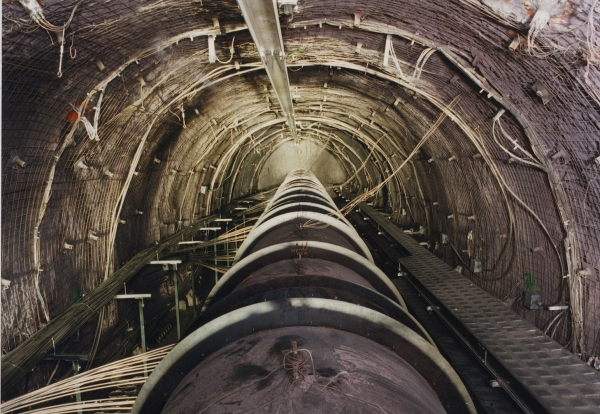Natural nuclear reactors, power plants and landscape:
A brief history of design
Power plant designs can vary in their fuels, coolants and configurations, as WiredScience describes in the article Reactor Drawings Make Nuclear History Beautiful. Now there are lots of discussions about the construction of new power plants worldwide, due its environmental influence over nature, but we want to focus on their design that sometimes resemble a dystopic urban landscape or the massive mobile robotic structures projects designed by the avant-garde architects from the 60s and 70s.
It is often claimed that nuclear stations are inflexible in their output. Whilst it may have been true for certain reactors, this is not longer true of at least some modern designs, as we can see e.g. in France, where the French government decided in 1974, just after the first oil shock, to greatly expand the country’s nuclear power capacity. We can also read in The History of Nuclear Energy:
Nuclear powerplants generate electricity like any other steam-electric powerplant. Water is heated, and steam from the boiling water turns turbines and generates electricity. The main difference in the various types of steam-electric plants is the heat source. Heat from a selfsustaining chain reaction boils the water in a nuclear powerplant. Coal, oil, or gas is burned in other powerplants
We’re talking about all of these to get the context to understand the design behind the nuclear reactors and power plants showed in these drawings:

The World’s Reactors, No. 11, Bradwell-On-Sea Power Station, Bradwell-on-Sea, Essex. Wall chart insert, Nuclear Engineering, April 1957
Electricity was generated for the first time by a nuclear reactor on December 20, 1951, at the EBR-I experimental station near Arco, Idaho, which initially produced about 100 kW [the Arco Reactor was also the first to experience partial meltdown, in 1955].
But going further in time, we found out that remnants of nuclear reactors nearly two billion years old were found in the 1970s in Oklo, Africa. Two billion years old? The explanation is that these reactors are thought to have occurred naturally. No natural reactors exist today, as the relative density of fissile uranium has now decayed below that needed for a sustainable reaction. As read in the web-site:
Creating a nuclear reaction is not simple. In power plants, it involves splitting uranium atoms, and that process releases energy as heat and neutrons that go on to cause other atoms to split. This splitting process is called nuclear fission. In a power plant, sustaining the process of splitting atoms requires the involvement of many scientists and technicians.It came as a great surprise to most, therefore, when, in 1972, French physicist Francis Perrin declared that nature had beaten humans to the punch by creating the world’s first nuclear reactors. Indeed, he argued, nature had a two-billion-year head start.1 Fifteen natural fission reactors have been found in three different ore deposits at the Oklo mine in Gabon, West Africa. These are collectively known as the Oklo Fossil Reactors.
We can even discuss how nuclear power affects our landscapes. The Yucca Mountain Waste Repository is the perfect example to talk about this issue, because following 20 years of intense study, Yucca Mountain[Nevada] has become the site for long term management and underground storage of the country’s growing stockpiles of high-level radioactive nuclear waste. This means that the mountain will be excavated for a tremendous phased development of the repository. We can read that the footprint of the facility is 1km wide x 6.5km long and comprises some 50 storage tunnels or ‘emplacement drifts’ for a total of some 56 miles or 90km of 5.5m to 7.6m diameter tunneling. In addition there is an elaborate ventilation system comprising several deep shafts and a shaft connection from each emplacement adit to a central service tunnel that runs the length of the footprint beneath the repository.
More than ten years before of the current state of the discussion about using Yucca Mountain as an option for storing nuclear waste, the mountain was excavated by a 25-foot diameter borer machine to open the other end of the tunnel three miles south of the north portal. For most of its length the tunnel is about a thousand feet beneath the summit of the mountain and even more important a thousand feet above the water table, as can be read at Atlas Obscura article. They pointed:
The more than five miles of tunnels, cross drifts and alcoves that have been drilled so far are really part of what is called the Exploratory Studies Facility. It is a research program, costing $8 billion so far, intended to prove the absolute safety of the repository for ten thousand years. If it morphs into the actual nuclear waste site then they will bore another sixty miles of tunnels branching off the main one where they will actually store the hot waste.
As we started talking about design, we can end this article quoting part of the interview that Geoff Manaugh andNicola Twilley did to Abraham Van Luik, a geoscientist with the U.S. Department of Energy [currently based at the nuclear waste-entombment site proposed for Yucca Mountain]:
BLDGBLOG: How did you start designing a project like Yucca Mountain, when you’re dealing with such enormous timescales and geological complexity?Abraham Van Luik: You start with a question: how do you perceive the need to isolate a material from the environment?I think most people would begin to answer that by looking at the nature of the material. Wherever that material is currently, we make sure that there is either a thick wall or a deep layer of water to protect the people working around it [...] Now, in most countries, what they have done next is asked: What geology would be very good for isolating this material from the environment? And what geologies are available in our country?
Now, the reflection here could be: are we architects prepared to respond or to design this kind of large-scale infrastructures? The discussion started when FASLANYC pointed, “what value do landscape/architects add to the design of infrastructures?” and was followed by Rob and Stephen at mammoth’sthe dead sea works. It can be continued here.
Of course we don’t have the answer, there are still so much things to do and think and we just want to go on with the conversation.
credit to : http://dprbcn.wordpress.com









Its rely fascinating that how far we have come and how fast we have grown on this field.
ReplyDeleteWhat i would like to know is according to the 2009,Obama Administration, stated that the site for Yucca Mountain Waste Repository was no longer an option and proposed to eliminate all funding in the 2009 United States federal budget.
after this site has been eliminated, although the site has been totally cleaned, im sure there would still be a small amount of radioactive waste discharge as radioactive substances does not deplete easily over the years,is there any other forms of counter measures to prevent this from occurring??